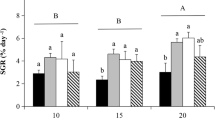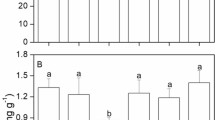Abstract
The marcoalga Ulva pertusa was cultured under (20 ± 2)°C, (20 ± 4)°C, (20 ± 6)°C, (20 ± 8)°C and (20 ± 10)°C circadian rhythms of fluctuating temperature conditions, and constant temperature of 20°C was used as the control. The growth rate of macroalga at (20 ± 2)°C, (20 ± 4)°C and (20 ± 6)°C were significantly higher than that at constant temperature of 20°C, while growth rate at (20 ± 8)°C and (20 ± 10)°C were significantly lower than that at constant temperature of 20°C. The growth rate of macroalga was a quadratic function of the thermal amplitude. Such a growth model can be described by G = β 0 + β 1(TA) + β 2(TA)2, where G represents the relative growth rate, TA is thermal amplitude in degree Celsius, β 0 is the intercept on the G axis, and β 1 and β 2 are the regression coefficients. The optimal thermal amplitude for the growth of thallus at mean temperature of 20°C was estimated to be ± 3.69°C. Analysis of biochemical composition at the final stages of thaulls growth revealed that diel fluctuating temperature caused various influences (P < 0.05). The content of chlorophyll, protein and total solute carbohydrate at (20 ± 2)°C and (20 ± 4)°C were slightly higher than those at constant temperature of 20°C, however no statistically significant differences were found among them (P > 0.05). While osmolytes (total solute carbohydrate and free proline) at (20 ± 10)°C were significantly higher than that at 20°C (P < 0.05). Therefore, more chlorophyll and carbohydrate production might account for the enhancement in the growth of macroalga at the diel fluctuating temperatures in the present study.


Similar content being viewed by others
References
Bates, L. S., R. P. Waldren & I. D. Teare, 1973. Rapid determination of free proline for water-stress studies. Plant and Soil 39: 205–207.
Bradfield, M. & N. Stamp, 2004. Effect of nighttime temperature on tomato plant defensive chemistry. Journal of Chemical Ecology 30: 1713–1721.
Bradford, M. M., 1976. A rapid and sensitive method for the quantization of microgram quantities of protein utilizing the principles of protein-dye binding. Analytical Biochemistry 72: 248–254.
Bredmose, N. & J. Nielsen, 2004. Effects of thermoperiodicity and plant population density on stem and flower elongation, leaf development, and specific fresh weight in single stemmed rose (Rosa hybrida L.) plants. Scientia Horticulturae 100: 169–182.
Danakusumah, E., S. Kadowaki & H. Hirata, 1991. Effects of coexisting Ulva pertusa on the producton of kuruma prawn. Bulletin of the Japanese Society of Scientific Fisheries 57: 1579–1603.
Davison I. R. & G. A. Pearson, 1996. Stress tolerance in intertidal seaweeds. Journal of Phycology 32: 197–211.
Dong, Y., S. Dong, X. Tian, F. Wang & M. Zhang, 2006. Effects of diel temperature fluctuations on growth, oxygen consumption and proximate body composition in the sea cucumber Apostichopus japonicus Selenka. Aquaculture 2006 255: 514–521.
Figueroa, F. L., C. Nygård, N. Ekelund & I. Gómez, 2003. Photobiological characteristics and photosynthetic UV responses in two Ulva species (Chlorophyta) from southern Spain. Journal of Photochemistry and Photobiology B: Biology 72: 35–44.
Fong, P., K. E. Boyer, J. S. Desmond & J. B. Zedler, 1996. Salinity stress, nitrogen competition, and facilitation: What controls seasonal succession of two opportunistic green macroalgae? Journal of Experimental Marine Biology and Ecology 206: 203–221.
Grimstad, S. O. & E. Grimanslund, 1993. Effect of different day and night temperature regimes on greenhouse cucumber young plant production, flower bud formation and early yield. Scientia Horticulturae 53: 191–204.
Guillard, R. R. & J. H. Ryther, 1962. Studies of marine planktonic diatoms: I. Cyclotella nana Hustedt, and Detonula confervaceae (Cleve) Gran. Canadian Journal of Microbiology 8: 229–239.
Jeffrey, S. W. & G. F. Humphrey, 1975. New spectrophotometric equations for determining chlorophylls a, b, c1 and c2 in higher plants, algae and natural phytoplankton. Biochemistry and Physiology Pflanzen 167: 191–194.
Jin, Q. & S. Dong, 2003. Comparative studies on the allelopathic effects of two different strains of Ulva pertusa on Heterosigma akashiwo and Alexandrium tamarense. Journal of Experimental Marine Biology and Ecology 293: 41–55.
Jin, Q., S. Dong & C. Wang, 2005. Allelopathic growth inhibition of Prorocentrum micans (Dinophyta) by Ulva pertusa and Ulva linza (Chlorophyta) in laboratory cultures. European Journal of Phycology 40: 31–37.
Kakinuma, M., Y. Kuno & H. Amano, 2004. Salinity stress responses of a sterile mutant of Ulva pertusa (Ulvales, Chlorophyta). Fisheries Science 70: 1177–1179.
Kakinuma, M., N. Shibahara, H. Ikeda, M. Maegawa & H. Amano, 2001. Thermal stress responses of a sterile mutant of Ulva pertusa (Chlorophyta). Fisheries Science 67: 287–294.
Klotke, J., J. Kopka, N. Gatzke & A. G. Heyer, 2004. Impact of soluble sugar concentrations on the acquisition of freezing tolerance in accessions of Arabidopsis thaliana with contrasting cold adaptation—evidence for a role of raffinose in cold acclimation. Plant, Cell and Environment 27: 1395–1404.
Konstantinov, A. S., V. V. Zdanovich & D. G. Tikhomirov, 1990. The effect of temperature oscillation on metabolic rate and energetics of young fish. Joural of Ichthyology 29: 1019–1027.
Lartigue, J., A. Neill, B. L. Hayden, J. Pulfer & J. Cebrian, 2003. The impact of salinity fluctuations on net oxygen production and inorganic nitrogen uptake by Ulva lactuca (Chlorophyceae). Aquatic Botany 75: 339–350.
Littler, M. M., 1980. Morphological form and photosynthetic performances of marine macroalgae: Tests of a functional/form hypothesis. Botanica Marina 22: 161–165.
Liu, J. & S. Dong, 2001a. Comparative studies on utilizing nitrogen capacity between two macroalgae Gracilaria tenuistipitata Var. Liui (Rhodophyta) and Ulva pertusa (Chlorophyta): I. Nitrogen storage under nitrogen enrichment and starvation. Journal of Environmental Sciences 13: 318–322.
Liu, J. & S. Dong, 2001b. Comparative studies on utilizing nitrogen capacity between two macroalgae Gracilaria tenuistipitata Var. Liui (Rhodophyta) and Ulva pertusa (Chlorophyta):II. Feedback control of intracellular nitrogen pools on nitrogen uptake. Journal of Environmental Sciences 13: 323–327.
Liu J., S. Dong, X. Liu & S. Ma, 2000. Response of macroalgae Gracilaria tenuistipitata var. liui (Rhodophyta) to iron stress. Journal of Applied Phycology 12: 605–612.
Mitchell, R. A. C., D. W. Lawlor & A. T. Young, 1991. Dark respiration of winter wheat crops in relation to temperature and simulated photosynthesis. Annals of Botany 67: 7–16.
Mu, Y., F. Wang, S. Dong, S. Dong & C. Zhu, 2005. Effects of salinity fluctuation in different ranges on intermolt period and growth of juvenile Fenneropenaeus chinensis. Acta Oceanologia sinica 24: 1–7.
Neori, A., M. D. Krom, S. P. Ellner, C. E. Boyd, D. Popper, R. Rabinovitch, P. J. Davison, O. Dvir, D. Zuber, M. Ucho, D. Angel & H. Gordin, 1996. Seaweed biofilters as regulators of water quality in integrated fish-seaweed culture units. Aquaculture 141: 183–199.
Raffaelli, D. G., J. A. Raven & L. J. Poole, 1998. Ecological impact of green macroalgal blooms. Oceanography and Marine Biology 36: 97–125.
Shaked, R., K. Rosenfeld & E. Pressman, 2004. The effect of low night temperatures on carbohydrates metabolism in developing pollen grains of pepper in relation to their number and functioning. Scientia Horticulturae 102: 29–36.
Sun, C., J. Mao, B. Bai & Y. Bai, 2000. Studies of enzymology on diurnal change of temperature accelerating the rate of wheat seedling growth. Journal of Jilin Agricultural University 22: 30–33 (in Chinese, with English abstract).
Tan, H., J. Li & Y. Lei, 1999. A preliminary study on purification of water contaminated by Haliotis dicus hannai lno. Tropic Oceanology 18: 20–26.
Tarutani, K., Y. Niimura & T. Uchida, 2004. Short-term uptake of dissolved organic nitrogen by an axenic strain of Ulva pertusa (Chlorophyceae) using 15N isotope measurements. Botanica Marina 47: 248–250.
Taylor, R., R. L. Fletcher & J. A. Raven, 2001. Preliminary studies on the growth of selected ‘green tide’ algae in laboratory culture: Effects of irradiance, temperature, salinity and nutrients on growth rate. Botanica Marina 44: 327–336.
Tian, X. & S. Dong, 2006. The effects of thermal amplitude on the growth of Chinese shrimp Fenneropenaeus chinensis (Osbeck, 1975). Aquaculture 251: 516–524.
Tian, X., S. Dong & F. Wang, 2004. The effects of temperature changes on the oxygen consumption of Chinese shrimp. Journal of Experimental Marine Biology and Ecology 310: 59–72.
Wang, J., C. Jin, X. Zhang & G. Liu, 2001. Polyculture of experiment Penaeus chinensis with various biomass of Ulva pertusavar. Journal of Fisheries of China 25: 32–37 (in Chinese, with English abstract).
Went, F. W., 1944. Plant growth under controlled conditions. II. Thermoperiodicity in growth and fruiting of the tomato. American Journal of Botany 31: 135–149.
Yemm, E. W. & A. J. Willis, 1954. The estimation of carbohydrates in plant extracts by anthrone. Biochemical Journal 57: 508–514.
Yin, X., M. J. Kropff & J. Goudriaan, 1996. Differential effects of day and night temperature on development to flowering in rice. Annals of Botany 77: 203–213.
Acknowledgements
The authors thank Prof. Taniguchi for his kind supply of the axenic nonsexual strain of U. pertusa, and Dr. Yunwei Dong and Xidan Zhao providing assistance in the care and maintenance of the experiment. This work was supported by National Eleventh Five-year Scientific and Technological Key Project (Grant No. 2006BAD09A01) and Hi-Tech Research and Development Program of China (Grant No. 2006AA10Z409).
Author information
Authors and Affiliations
Corresponding author
Additional information
Handling editor: S. M. Thomaz
Rights and permissions
About this article
Cite this article
Wang, Q., Dong, S., Tian, X. et al. Effects of circadian rhythms of fluctuating temperature on growth and biochemical composition of Ulva pertusa . Hydrobiologia 586, 313–319 (2007). https://doi.org/10.1007/s10750-007-0700-z
Received:
Revised:
Accepted:
Published:
Issue Date:
DOI: https://doi.org/10.1007/s10750-007-0700-z




